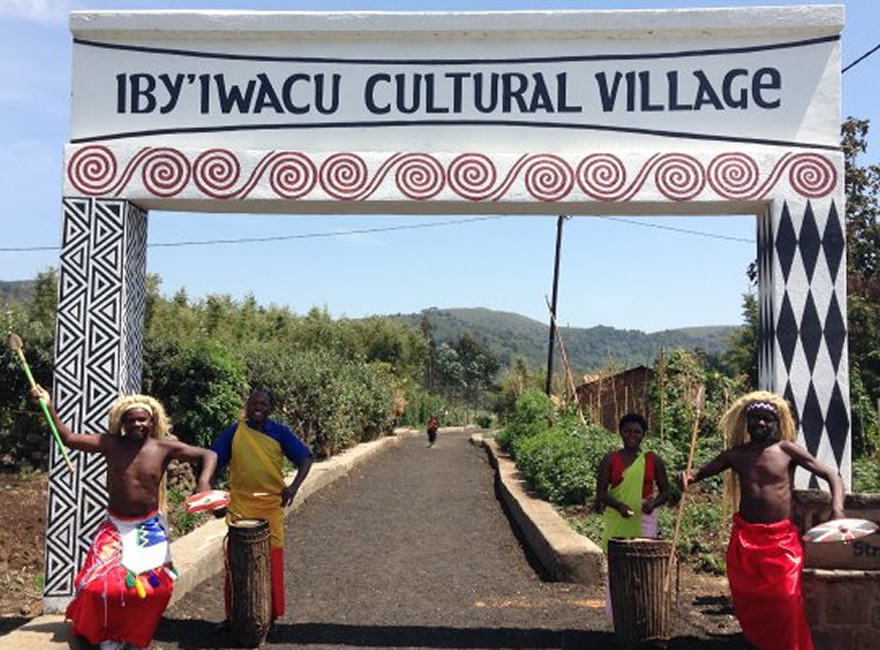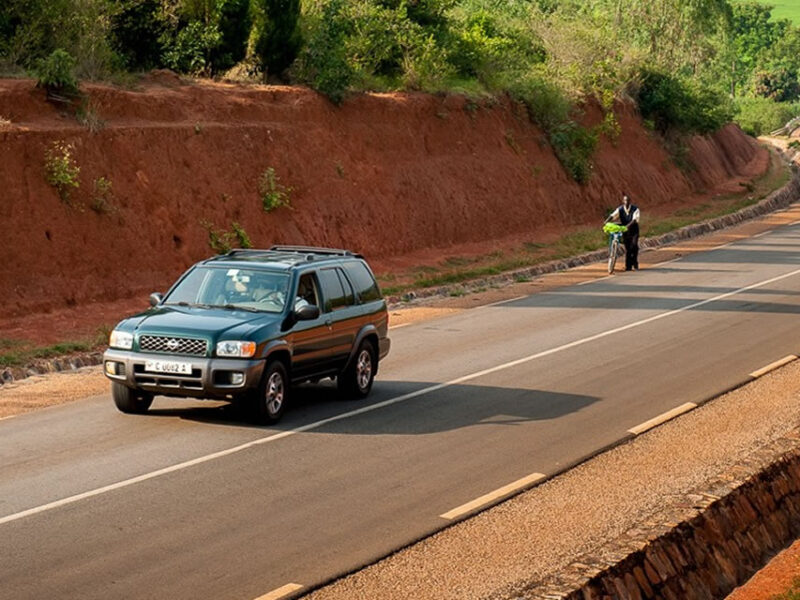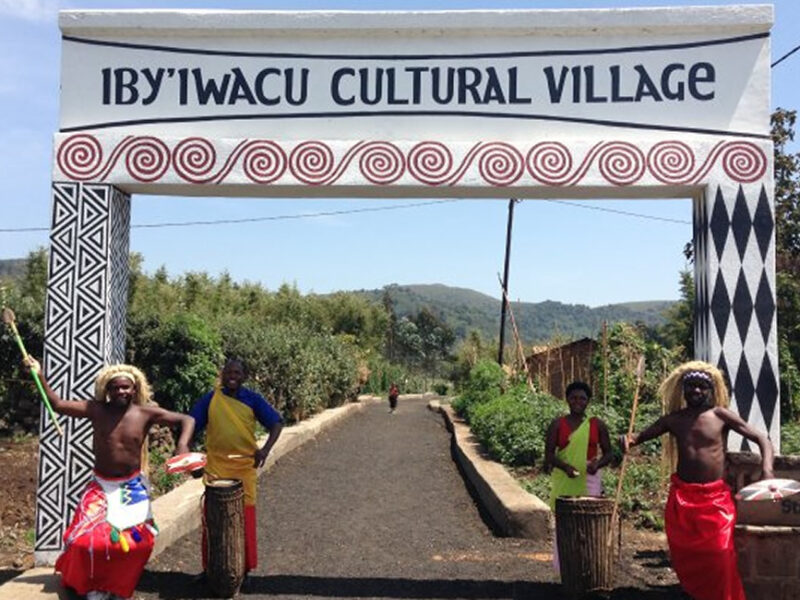
Iby’Iwachu Cultural Village in Kinigi
It was a Friday afternoon when I boarded the bus to Musanze district, formerly known as Ruhengeri. This is one of the most famous places in the world, renown for its mountain Gorillas. When most people visit Ruhengeri their main purpose is to go Gorilla trekking but I have fallen in love with the beautiful scenery that is filled with ever-green, cool weather, abundant fresh air, and friendly lovely people. In the previous issue of The Eye Rwanda, our cultural article talked about former poachers who had embraced cultural and ecological tourism. So I went up the mountain, a height of about 2200 meters above sea level, to experience and learn more about the Iby’Iwachu Cultural village, a new Tourism destination in Kinigi.
The people in this community all have different cultural backgrounds. Some are pygmies who were naturally forest dwellers who depended heavily on poaching and gathering fruit from the forest in the national park, while other local residents were peasant farmers who supplemented their daily survival by encroaching on the resources in the Volcanoes National Park, Rwanda. Therefore relocating and resettling these people outside the park and trying to change their behavior caused an incredible amount of conflict between the National Park authorities and the local people. What is amazing is how the local people, who were against the policies of wildlife and environmental conservation, have turned around to appreciate, embrace and add value to the tourism packages of Rwanda. It has been a long process of sensitization, dedication, and commitment by a group of people headed by Edwin Sabuhoro from Rwanda Ecotours. The whole process began by setting up a council of elders from the community, which is estimated to have a population of 1500 people. Once the elders had come up with the concept they invited other families to join in then it was a matter of educating the younger generation in all of the households.
What does the cultural village have to offer?
The major attraction at the Ibywachu Cultural Village is a replica of the king’s palace, the second of its kind in the country. It offers a lot of history where you can learn all about the cultural norms and taboos of ancestral behavior. Once inside, the main house is grass-thatched with many poles supporting the roof. Each pole has its own norms associated, and in the middle, you have four fireplaces. This is where the parliament was where the king used to meet with the chiefs to resolve the issues of the kingdom. There are also two doorways; one which was used by the king and the other by the rest of the people. The palace also has a mini-museum where old collectibles like coins, cups, plates, knives, spears, and shields are displayed.
At the palace, there is an opportunity to meet Lulengwa who is a traditional healer who has been practicing local medicine since childhood. He told me that all his great-grandparents had been traditional healers. Lulengwa plays a vital role in this village by treating fellow community members with local herbs that he collects from the surrounding bushes. You can imagine this community without a Clinic or hospital and he boasts of curing diseases such as skin ailments, impotence, easing labor pains, malaria, food poisoning, stomach worms, and mental disorders. The hospital is about 20kms away and there is no ambulance, so if Dr.Lule’s prescription fails then referrals are made to Ruhengeri hospital for further treatment. It’s a memorable experience to watch the traditional healer performing his tasks.
The traditional folk dancers at the cultural village are stunning. The smiles of sheer joy are evident on their faces as they move to the rhythm of the lyrics – I found it very interesting to watch. As traditional Intore and Ekinimba dancers (all of whom have been active poachers for centuries) share their amazing traditional dance and drum sounds clapped with gorilla sounds integrating what humans and wildlife miss in their search for inter-dependence. The drums are kept in a special hut and are placed on the ground in a circular shape in the middle. The drummers light a fire to keep the leather on top well stretched, enabling the drums to produce a good sound. At night it’s always cold so you get seated in the King’s house around the fireplace where you are entertained with solo auditions while the harps can be heard. In the King’s house, you are served local beer which is brewed from bananas and sorghum.
The former poachers also perform shooting skills using bows and arrows, displaying their skills used in hunting. It’s amazing to see how they can aim to hit a bamboo shoot at a range of 80 meters away, and hit it. They also display other items that were used for poaching as well as narrating their encounters with elephants and various other wild animals.
Some of the community members acquired skills from their great-grandparents in iron black smelting. They show the traditional ways of iron smelting, and how they used to make arrows, spears, and knives which were essential tools of their homesteads.
The transformation of the community from poaching to cultural tourism has involved organizing themselves into a group of ten, each group handling a particular task and being trained in modern agricultural techniques. The groups have been provided with tools like hoes and machetes plus hybrid seeds that yield better crops. Preparations are underway that will enable the community access to better markets rather than selling to middlemen who offer them lower prices.
The animal husbandry group has been received via donations, hybrid goats and chickens too rare for commercial purposes. They’ve faced challenges in keeping these animals because they’ve been accustomed to eating game meat all of their life. Due to the various intervention and sensitization programs, they have realized the importance of progress and modernity.
The school has only one classroom under a grass-thatched shelter and one teacher has been hired to help teach English to the children as well as the elders. Teaching English to poachers who wish to tell their until now, untold story is empowering to the local people and is the foundation for their sustainability and preservation of their history. It’s not all about giving people a fish in order to feed themselves but rather a way of teaching people how to fish to sustain themselves.
The most important aspect is conservation and embracing tourism. This cultural village has been developed to help the community understand the need and benefits of environmental conservation. Your visit to this cultural village contributes a lot to change the lives of different people.
Each visitor to the village pays US$20 for all the activities in the cultural village. Camping for a night at the village costs US$20, which all goes towards the village fund. Forty percent goes directly to the activities, while the other sixty goes into the village fund (or bank), after which the village committee decides where to invest the money amongst projects such as paying health insurance for families, buying high-breed seeds, sponsoring children, and buying scholastic materials, and developing small scale businesses, not only to boost their food capacity and to deal with their scale economies but also to start enterprising to benefit from tourism and be part of the conservation efforts to save the endangered species in their surroundings.


